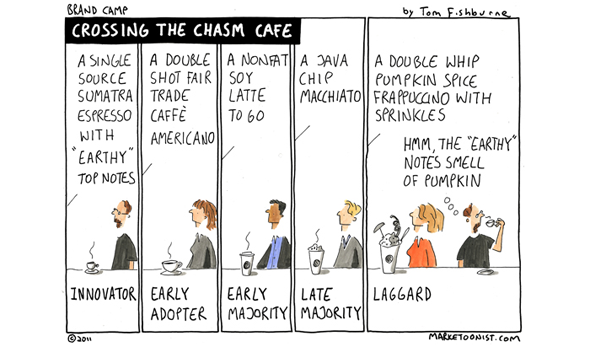The Power of Empathy (video link)
Post-election, some of us are grieving, and fall somewhere in this spectrum:
denial > anger > bargaining > depression > acceptance
I think election night was proof that the Coasts, and a few other states are out of touch with the needs and concerns of majority of the nation.
Though the outcome sent shock waves through the U.S. an the rest of the world, if we can lay our own biases aside and lean in with what empathy we can muster, I think we will find that some Trump voters weren’t voting to undo progress. I do think voters were determined to send a clear message, using the best vehicle they had, to say “while aspirational goals are well and good, it’s time to put me first.”
I am what you might consider a “gritty optimist,” and, I do think there is an opportunity here to have a new dialogue rise from the ashes. We have the technology to support new conversations and collaboration, starting first where values align, then moving to the more contentious issues.
Many would say that our parties are not effectively reflecting the priorities of the citizenry. I would encourage Republicans and Democrats to go on a listening tour. Be curious — why did democrats vote for Trump? What were they voting for/against? Before taking action, learn what your constituent’s priorities are.
As a nation, we need to find a middle way. Perhaps this is that opportunity. Let’s have empathy for each other and lean into the other side. Identify the pains and fears that were not addressed and experiment our way forward. Perhaps we can find a way to have this outcome join rather than divide us.
America is great. Let’s use our ingenuity to disrupt ourselves and seize this opportunity to fix what’s broken.
Culture
Years ago, at a beach resort in Dubai, I ran out into the surf, and was suddenly caught in a rip current. Having been a lifeguard for years back in high school, I told myself, “don’t panic, you’ll figure something out.” After struggling for a number of minutes, with the current sweeping me toward an extremely rocky jetty, I finally panicked.
As it turned out, I wasn’t far from the edge of the current. A nearby swimmer pulled me over a few feet, far enough to escape the most severe current. With help, I escaped the grip of the rip. Just in time, too. Back on the beach, the lifeguard saw what was happening and was ankle-deep in the water, rescue tube in hand. Apparently four other tourists had washed against the jetty the previous day.
The norm in most companies is “when you’re stuck, think harder.” This solitary activity requires a lot of time and energy. Worse, it may not result in a viable solution. This is because we get stuck in a fixed way of viewing the problem. We can’t see our own blind spots.
Since it’s summer here in California, and many of us are at the beach, I thought I’d use the analogy of a rip current to illustrate how to escape a rip mindset. Following are a set of steps to help you “break the grip of the rip.”
In the past, professionals typically devoted their entire careers to companies that valued their functional or technical skills, not their social ones. Today’s lightning-fast business environment demands job candidates who can step into senior management roles in five to eight years, often in decentralized and constantly transforming enterprises, in relationship-based professions like investment banking and consulting, and in dynamic and diverse communities. In such organizations, leadership success is often defined in interpersonal terms: knowing how and when to collaborate or command, how to lead and develop subordinates, or how to manage and empower networks.
Excerpt from the Forward to the book Leading with Kindness
R. Glenn Hubbard, Dean and Russell L. Carson, Professor of Finance and Economics
Columbia Business School
If this is true for effective leaders, and feedback is craved by employees who want to continue to grow and develop, why is actionable, compassionate feedback so hard to provide?
Getting a product out the door is no easy feat. Often, ideas and prototypes stall on their way out the door because of a simple tactical error – falling in love with the expression of the original insight.
In Crossing the Chasm, Geoffrey A. Moore advocates using each customer segment to market to the next one, making adoption less risky and more socially acceptable. Similarly, the most difficult step in gaining internal traction for a disruptive innovation is making the transition between visionaries (early adopters) and pragmatists (early majority).
After uncovering a new market opportunity, product teams need language to describe the new solution. Since the product is the first of its kind, they create their own words to describe it.
Authentic communication and understanding are critical to team effectiveness. This is the first of a series of posts on this topic. I hope you’ll adapt and integrate the ones you like into your own team culture.
The single biggest problem in communication is the illusion that it has taken place. –George Bernard Shaw
Last weekend, team effectiveness, development, marketing and agile professionals converged at PlayCamp. I was reminded me of a valuable scrum exercise I learned from Matt Smith called “I don’t see it, help me see it.”
It can be used in an Agile context to clarify user stories, but I also think it makes a nifty habit for teams to ensure everyone is on the same page.
How It Works
When someone says “I don’t see it, help me see it” this serves as a signal that whatever was just said is unclear to one or more team members.
Mike: [Mike communicates something important to the team he leads or is a member of (v 1.0)]
Alan: “I don’t see it, help me see it”
Mike: [Mike tries again, using different words (v 2.0)]
Alan: “I still don’t see it, help me see it”
Sue: [Communicates it yet a different way using her own words, and/or a visual (v 3.0)]
If Alan understands, he’ll tell Sue and Mike he gets it. If not, other members of the team will jump in to clarify. The ensuing discussion ensures all team members are on the same page.
I facilitate action-learning sessions for various companies. During these sessions, project owners arrive with a problem or challenge. Over the course of the day, teams unpack their challenges, identify assumptions and possible solutions, then design experiments to test their assumptions before placing bigger bets with their resources.
After one such session, an executive pulled me aside and asked “how can I make my team more curious?” This question still nags at me.
Over the past three years, I have noticed a disturbing trend: declining curiosity among students and corporate citizens in the U.S.
Where has our curiosity gone?
I have a number of hypotheses about this. Here are three…
Read More»



















Follow Us!